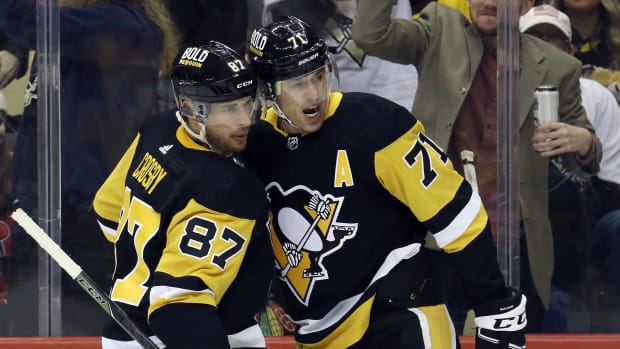Welcome to the newest file in THN.com’s ongoing analyses of the off-season moves of the NHL”s teams. On this day, we’re examining the Pittsburgh Penguins..
2021-22 Record: 46–25-11
Finish In The Metropolitan Division: 3rd
Salary Cap Space Available (As Per CapFriendly.com): $0 ($480,175 over salary cap ceiling)
What The Penguins Have: Still a dominant, Grade-A force in superstar center and captain Sidney Crosby; a returning goalie tandem in starter Tristan Jarry and Casey DeSmith; high-impact veterans in Evgeni Malkin, Kris Letang, Jake Guentzel, Bryan Rust, Rickard Rakell and Jeff Carter; a fully-signed roster
What The Penguins Need: Better luck on the health front; an improved showing in shootouts (they were 3-7 last season); more production from winger Jason Zucker, who had only eight goals and 17 points in 41 games last season; immediate salary cap flexibility; a replenished prospects pool; more youth to their defense corps; a way to get beyond the first round of the Stanley Cup playoffs for the first time in five years
What’s Realistic For The Penguins Next Season: Pittsburgh operates under relatively new owners. Still, their competitive goals haven’t changed, and neither has GM Ron Hextall`s faith in his longtime core of talent. The team could`ve taken a major change in direction this summer, with cornerstone stars Malkin and Kris Letang both unrestricted free agents. Instead, Hextall re-signed both, even if it meant slightly exceeding the salary cap’s upper limit.
Consequently, the Pens will continue to have one of the NHL’s older rosters, particularly on defense, where five of their blueliners are at least 30 years old. Years of dealing away prospects have taken their toll, and Hextall will continue to have a hard time competing on the trade market. They did re-sign former Ducks winger Rickard Rakell, but fellow veteran winger Jason Zucker is their fourth highest-paid forward, and Zucker struggled mightily for the second consecutive year. He’d be a prime candidate to be traded if he wasn’t earning $5.5 million in the final year of his current contract and if Pittsburgh was interested in dealing away a first-round draft pick to consummate any deal. Right now, they aren’t, but they don’t have enough depth not to consider moving a high pick at some point during the 2022-23 season.
It’s somewhat curious that Hextall stayed out of the UFA market to change Pittsburgh’s tandem in net. Starter Tristan Jarry was always coming back, but backup Casey DeSmith was a UFA, and his numbers (including a 2.79 Goals-Against Average and .911 save percentage) weren’t so spectacular as to warrant his return, even if at only a relatively small pay raise. If Jarry struggles during the regular season or playoffs, it’s tough to see DeSmith as an answer between the pipes.
Hextall made one of only a few changes this summer when he traded for former Canadiens D-man Jeff Petry. The 34-year-old Petry saw his offensive numbers fall off notably on a dismal Montreal team last season. He also has had a very difficult time staying healthy – he’s missed a combined 41 games in the past two seasons – and carries a $6.25 million cap hit for the next three seasons, $150,000 a year more than it cost them to bring back Letang for the next six years. That is a significant gamble on Hextall’s behalf.
A time of reckoning inevitably comes for all NHL teams in their competitive cycle, and while Pittsburgh continues to employ talent that all GMs in the game would kill for, it really does seem like the law of diminishing returns is in the early, if-not mid-stages of the Penguins’ present-day trajectory.
Sometimes familiarity is a good thing for teams; sometimes it can be a crutch to satisfy fan and management’s long-held faith in their core. We should find out in short order what kind of team Pittsburgh is, and whether the Pens can flip the bird to Father Time and go on what may be their final deep playoff run with their current group.



